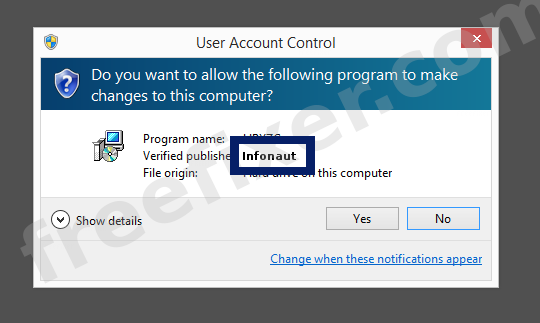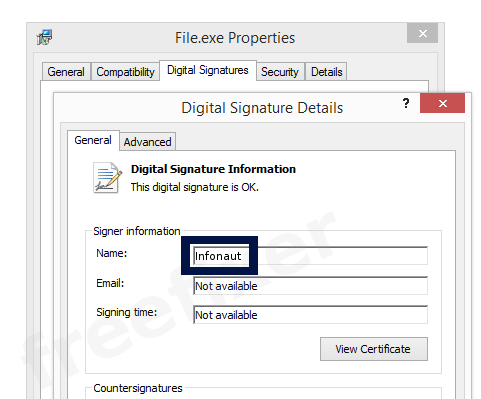Infonaut - 22% Detection Rate *
Did you just stumble upon a download or a file on your computer that is digitally signed by Infonaut? Some of the security products refers to the detected files as InfoAtoms (fs) and HEUR/QVM10.1.Malware.Gen. The detection rate for the Infonaut files collected here is 22%. Please read on for more details.
You will typically notice Infonaut when running the file. The publisher name is displayed as the "Verified publisher" in the UAC dialog as the screenshot shows:

You can view the digital signature details for Infonaut with the following procedure:
- Open up Windows Explorer and locate the Infonaut file
- Right-click the file and select Properties
- Click the Digital Signatures tab
- Click the View Certificate button
Here is a screenshot of a file signed by Infonaut:

As you can see in the screencap above, Windows states that "This digital signature is OK". This means that the file has been published by Infonaut and that the file has not been tampered with.
If you click the View Certificate button shown in the screenshot above, you can examine all the details of the certificate, such as when it was issued, who issued the certificate, how long it is valid, and so on. You can also view the address for Infonaut, such as the street name, city and country.
GlobalSign CodeSigning CA - G2 has issued the Infonaut certificates. You can also see the details of the issuer by clicking the View Certificate button shown in the screengrab above.
Infonaut Files
These are the Infonaut files I have gathered, thanks to the FreeFixer users.
| Detection Ratio | File Name |
|---|---|
| 12/55 | insvc.exe |
| 16/57 | insvc.exe |
| 9/57 | innfd_1_10_0_14.sys |
Scanner and Detection Names
Here is the detection names for the Infonaut files. I have grouped the detection names by each scanner engine. Thanks to VirusTotal for the scan results.
| Scanner | Detection Names |
|---|---|
| AVG | Generic.300 |
| AVware | InfoAtoms (fs) |
| Agnitum | PUA.Popad! |
| Avira | ADWARE/Adware.Gen7 |
| Baidu-International | Adware.Win32.Vitruvian.F, Hacktool.Win32.NetFilter.A |
| Comodo | ApplicUnwnt |
| DrWeb | Adware.Yontoo.73, Adware.Plugin.924 |
| ESET-NOD32 | a variant of Win32/Adware.Vitruvian.F, a variant of Win32/NetFilter.A potentially unsafe |
| Fortinet | Riskware/Vitruvian |
| GData | Win32.Application.Agent.BS70Q6 |
| Ikarus | PUA.Vitruvian |
| Jiangmin | AdWare/Vitruvian.m, AdWare/Vitruvian.c |
| Kaspersky | not-a-virus:AdWare.Win32.Vitruvian.g |
| McAfee | Artemis!D1AFCCBC2BC5 |
| NANO-Antivirus | Riskware.Win32.Vitruvian.dnpzum |
| Panda | Generic Suspicious |
| Qihoo-360 | HEUR/QVM10.1.Malware.Gen, HEUR/QVM00.1.Malware.Gen |
| Sophos | Generic PUA CA |
| Symantec | WS.Reputation.1 |
| Tencent | Win32.Adware.Vitruvian.Lpuw |
| TrendMicro-HouseCall | Suspicious_GEN.F47V0413, Suspicious_GEN.F47V0403 |
| VBA32 | AdWare.Vitruvian |
| VIPRE | InfoAtoms (fs) |
| Zillya | Backdoor.CPEX.Win32.30054 |
* How the Detection Percentage is Calculated
The detection percentage is based on that I've collected 169 scan results for the Infonaut files. 37 of these scan results came up with some sort of detection. You can view the full details of the scan results by examining the files listed above.
Analysis Details
The analysis has been done on certificates with the following serial numbers:
- 1121249331b912f35dffc0450af358b52dd8